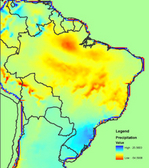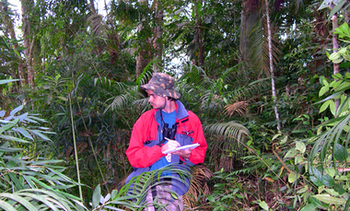Monitoring climate-relevant biodiversity in protected areas
Project description
Title: Monitoring climate-relevant biodiversity at protected area level with regard to mitigation and adaptation measures
Commissioned by: German Federal Ministry for the Environment, Nature Conservation, Building and Nuclear Safety (BMUB)
Country: Brazil
Lead executing agency: Ministério do Meio Ambiente (MMA)
Overall term: 2010 to 2014

Context
Brazil is home to between 15 to 20 per cent of global biodiversity and thus to the largest species diversity anywhere in the world. Protecting this biological wealth and its ecosystems is of central importance as people here and the world over depend on the earth’s ecosystem services, e.g. for their drinking water supplies, for climate regulation and for greenhouse gas storage.
To safeguard its biodiversity, Brazil has set up a national protected area system consisting of around 700 public and 900 private protected areas that span an expanse four times the size of Germany. A national monitoring system is needed in order to assess the state of these areas and to manage them appropriately.
In the Amazon region, Brazil already has an excellent satellite-based system for monitoring forest cover that swiftly detects deforestation and forest fires. While this form of monitoring is being extended to other regions, local monitoring in the protected areas and, as a consequence, the precise observation of biodiversity on the ground, is still in its early stages.
Against this backdrop, a local monitoring system is currently being set up in the protected areas of the Amazon, Cerrado and Mata Atlântica regions. With the participation of local people, the status quo of these ecosystems and the impact of climate change on their biodiversity are now being evaluated.
Objective
Monitoring climate-relevant biodiversity in Brazilian protected areas delivers results for successful climate and biodiversity protection.
Approach
On behalf of the German Federal Ministry for the Environment, Nature Conservation, Building and Nuclear Safety (BMUB), GIZ is working with the Brazilian Ministry for the Environment and with the Instituto Chico Mendes de Conservação da Biodiversidade, (ICMBio), the Brazilian agency responsible for managing the federal protected areas.
The project is assisting its partners to set up a participatory system for monitoring climate-relevant biodiversity in Brazil’s protected areas. This involves developing methods to track biodiversity and carbon sinks, integrating climate and biodiversity information systems and promoting expertise and resources for monitoring biodiversity and disseminating knowledge.
This monitoring system is designed to supply information that will lead to a better understanding of biodiversity’s significance and thus assist in mitigating climate change and adapting to its inevitable consequences. Specifically, this knowledge is to be used to enhance the local management of protected areas and for national decisions on climate and biodiversity protection.
As part of its International Climate Initiative (IKI), the German Federal Ministry for the Environment, Nature Conservation, Building and Nuclear Safety (BMUB) promotes measures for monitoring climate-relevant biodiversity in Brazil with EUR 4 million for technical cooperation.
Results
Together with renowned specialist institutions and universities, the project has specified indicator groups – large mammals or certain bird species, for example – which it has agreed at national level, along with methods for local-level monitoring. Thanks to this broad-scale consensus, the institutions are now able to pursue a coherent and coordinated approach.
Federal states and non-governmental actors are showing great interest in the experience gathered from pilot monitoring activities in 18 protected areas with ICMBio. This can potentially be applied to any area in Brazil with the help of the Brazilian LifeWeb Initiative.
Better methods for calculating biomass have improved CO2 measurements, enabling the effective implementation of compensation mechanisms or PES projects (payment for environmental services) in and outside the protected areas.
With the aid of innovative computer instruments, biodiversity data collected in the field are used to glean valuable information for the local and national management of protected areas.
In cooperation with the Brazilian National Institute for Space Research (INPE), climate scenarios have been devised through to the year 2100 to help predict climate change and its impact on biodiversity in Brazil. Corresponding analyses are also undertaken and published jointly with centres of excellence, such as the University of São Paulo.
Publications and methodologically innovative manuals for use on site mean that in principle monitoring can be performed by anyone. The outcome of this will be greater awareness not only on the part of decision-makers but also among civil society of the link between biodiversity and climate protection and the importance of intact eco-systems for climate protection.

With the aid of innovative computer instruments, biodiversity data collected in the field are used to glean valuable information for the local and national management of protected areas.
In cooperation with the Brazilian National Institute for Space Research (INPE), climate scenarios have been devised through to the year 2100 to help predict climate change and its impact on biodiversity in Brazil. Corresponding analyses are also undertaken and published jointly with centres of excellence, such as the University of São Paulo.
Publications and methodologically innovative manuals for use on site mean that in principle monitoring can be performed by anyone. The outcome of this will be greater awareness not only on the part of decision-makers but also among civil society of the link between biodiversity and climate protection and the importance of intact eco-systems for climate protection.